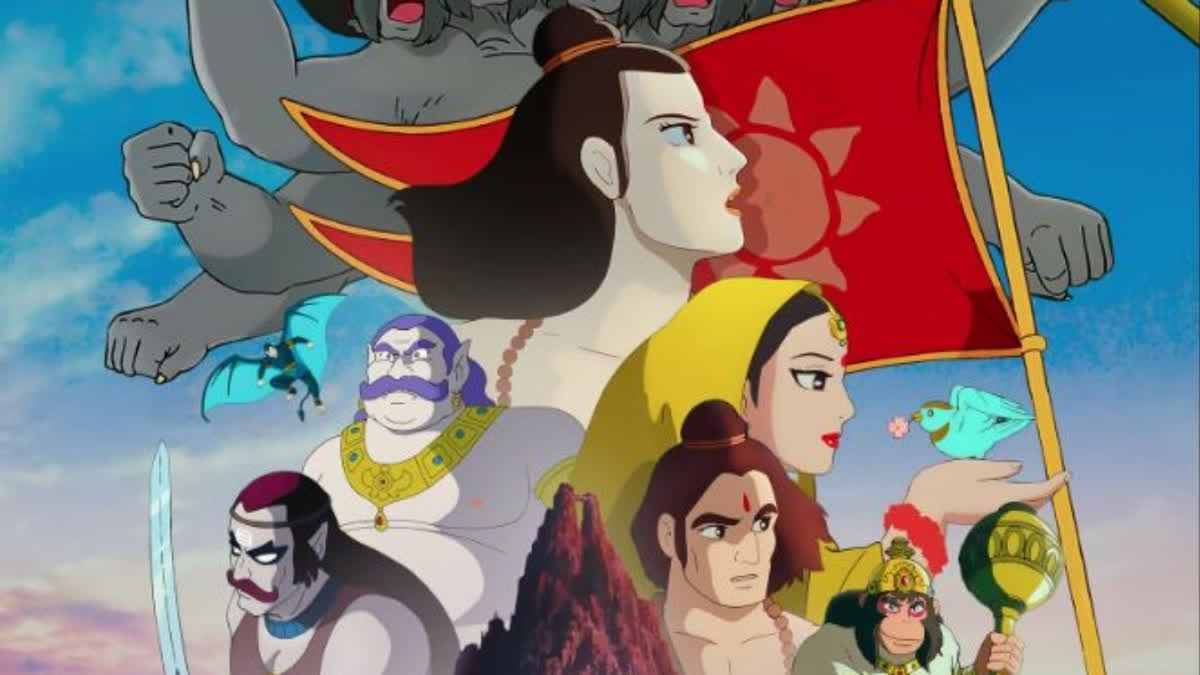Hyderabad: Ramayana: The Legend of Prince Rama, the iconic Indo-Japanese animated film, is all set for a grand release in theatres on January 24, 2025. The film will be presented in stunning 4K resolution with enhanced audio, and will be available in Hindi, English, Tamil, and Telugu. The new release date has come after a long and tumultuous journey to reach Indian audiences, marked by multiple delays, bans, and controversies.
The long-awaited theatrical debut comes after 32 years since its initial release and marks a significant cultural milestone. The film's history, however, was not without challenges and controversies, particularly surrounding its depiction of Hindu gods by Japanese animators, leading to its delayed arrival in India.
The origins of Ramayana: The Legend of Prince Rama date back to the early 1980s when Japanese filmmaker Yugo Sako became fascinated with the Ramayana, one of the most revered epics in Indian mythology. He went on to read ten different versions of the Ramayana in Japanese. His admiration for the narrative and its rich cultural heritage drove him to propose an animated adaptation, which he believed would be the ideal medium to portray the divine nature of the characters, especially Lord Rama. Sako felt that animation would allow him to capture the essence of these deities better than live-action could.
The concept of a cross-cultural animation project, blending the art styles of Japan and India, was innovative and ambitious. The film, co-directed by Sako, Ram Mohan, and Koichi Sasaki, combined Japanese manga-style animation, Disney-like aesthetics, and traditional Indian art influenced by the works of Ravi Varma. The filmmakers' goal was to create a visually stunning and faithful adaptation of the Ramayana while bringing the story to a global audience. In 1993, the film was completed, and it premiered at the International Film Festival of India (IFFI), where it garnered much attention.
However, the film's release in India was not without problems. The 1990s were a politically charged time in India, particularly due to the Ram Janmabhoomi movement, which was centered around the construction of a Ram temple in Ayodhya at the site of the demolished Babri Masjid. This contentious political issue, combined with the communal tensions that were erupting across the country, made the release of a film about Lord Rama, particularly one produced by foreign filmmakers, highly sensitive.
The film was viewed by some as a foreign interpretation of a sacred Hindu text, and its portrayal of Hindu gods by Japanese animators did not sit well with conservative religious groups, particularly the Vishva Hindu Parishad (VHP). Amid the rising communal tensions, the VHP and other groups voiced their strong opposition to the film, arguing that it was inappropriate for foreign filmmakers to depict Indian gods and goddesses, especially in an animated format. The VHP even sent a letter to the Japanese embassy in New Delhi, protesting against the film's production and questioning its cultural legitimacy. As a result of these protests, and fearing further exacerbation of communal unrest, the Indian government decided to delay the film's release.
The situation became even more complicated when the Babri Masjid was demolished in December 1992, an event that led to widespread communal riots in India. With the country on edge, the film was deemed too controversial to release in theatres. It was banned in India, and the filmmakers were forced to look for other ways to share the film with Indian audiences.
Despite the ban, the film eventually found a platform through Doordarshan, India's state-run television channel. In 1995, Ramayana: The Legend of Prince Rama was broadcast on television, reaching a wide audience for the first time. The Hindi-dubbed version featured iconic Indian actors such as Arun Govil (Rama), Amrish Puri (Ravana), and Shatrughan Sinha (Narrator), who lent their voices to the characters, helping to bring the epic to life for Indian viewers. The film was warmly received by audiences who were captivated by its vibrant animation, compelling story, and faithful retelling of the Ramayana. However, its success on TV did little to overcome the stigma of its earlier censorship and the controversies surrounding its depiction of Hindu gods.
For many years, the film enjoyed being a beloved classic in Indian homes, often rerun on television channels like Cartoon Network and Pogo in the early 2000s. However, despite its popularity, the film remained largely absent from cinemas in India, with its potential to reach a wider audience stunted by the historical controversies that surrounded it.
Fast forward to 2025, and Ramayana: The Legend of Prince Rama is set to be re-released in theatres for the first time in 31 years. The film has been remastered in 4K, with enhanced sound and visuals. The theatrical release comes at a time when there is a widespread renewed interest in the Ramayana epic, especially in the wake of recent attempts like Om Raut's Adipurush and the upcoming film Ramayana featuring Ranbir Kapoor and Sai Pallavi.
Read More



